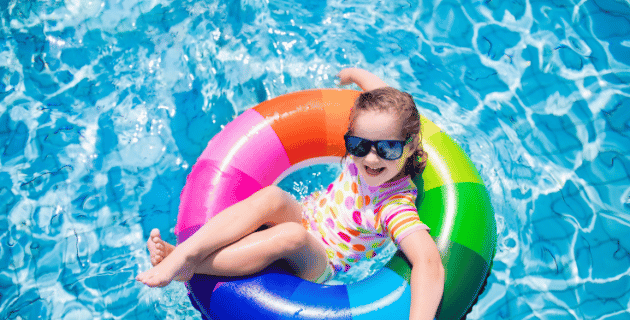
by California Casualty | Homeowners Insurance Info |
There’s nothing like a refreshing dip in the pool on a hot summer day. That’s why a swimming pool can be a great investment for your property. However, pools come with their fair share of risks, which is why protecting them with the right insurance is so important.
Swimming pools are covered under your homeowner’s insurance. They are covered in two ways: (1) other structures or personal property coverage and (2) liability insurance. The first covers damage to the pool. The second covers injuries to guests—both invited and possibly trespassers.
Other Structures or Personal Property Coverage
If your pool is in the ground or installed permanently above the ground on your property, it is covered under Coverage B – Other Structures. This is an insurance term describing a detached structure on your property. Other structures include pools, fences, gazebos, sheds, etc. However, if your pool is above-ground but portable, it is considered part of your personal property and covered by Coverage C – Personal Property insurance.
-
- Coverage B – Other Structures – insurance covers open perils. That means a loss is covered unless it’s excluded. Typical exclusions include flood, earthquake, or wear and tear.
-
- Coverage C – Personal Property – insurance covers named perils. That means the loss is only covered if it is one of the 16 named perils (for example, fire, explosion, theft, etc.).
If a tree falls on your pool and damages it, your policy would help with repairs, minus your deductible, the amount you chose to pay out-of-pocket before insurance kicks in.
-
- The coverage limit for other structures is generally set at 10% of your home’s coverage limit. That means if your home is insured for $200,000, the coverage limit for your pool would be $20,000. For an additional premium, you can add an endorsement for additional coverage: Other Structures – Increased Limits. You may wish to do so if your pool is worth more, such as if it has a deck, waterslide, diving board, or waterfall. (Note that some companies will not insure pools with slides and diving boards, as these can present additional risk.)
-
- Portable pools are covered under personal property. Depending upon the personal property limit that you set for your policy, you will get reimbursed if your pool is damaged by a covered peril. If your home is insured for $200,000, and your personal property coverage is 50%, 25%, your policy will pay up to $100,000 for repairs for covered perils. Personal property coverage for homeowners is 50% or 75%; renters may choose the amount that they wish for Coverage C.
This coverage comes with stipulations. You need to shut off the water supply and drain all systems and appliances of water at the end of the season. The loss may not be covered if the pool’s plumbing freezes. Insurers do not cover loss of property caused by faulty, inadequate, or defective maintenance.
Liability Coverage
If someone is injured — or tragically dies — in your pool, your liability policy can help to cover expenses from medical bills to lawsuits. This doesn’t apply to you or the members of your household but potentially covers any invited guests or even uninvited strangers.
Typical homeowner’s policies include $100,000 for base liability coverage. You will want to increase to the highest limit available if you have a swimming pool Alternatively, you can purchase a personal umbrella policy for additional coverage. An umbrella policy kicks in when you’ve reached the limits of your homeowner’s policy.
An Attractive Nuisance
Attractive nuisance is a term used to describe anything that might attract children and present a potential danger to them. Swimming pools are classified as attractive nuisances. As a homeowner, and owner of a pool, you are responsible to secure your pool to keep it as safe as possible from curious kids—or anyone else. Under the law, you may be found liable for any incidents even if you didn’t give someone permission to be on your property or in the pool.
-
- Install a fence around your pool and a locked gate to secure it.
- Install a locking pool cover that will hold the weight of an adult.
- Move the ladder away when your pool is not in use.
- Install an alarm that alerts you when someone is in the pool.
- Consider a security camera to help you monitor the pool.
- Follow any local laws on pool construction and safety.
Replacement Cost vs. Actual Cash Value
If the pool is portable, it is eligible for replacement cost under Coverage C. If it is not portable, you will insure it for actual cash value (ACV). ACV is the amount the item is worth, minus depreciation for its age. In a loss for other structures such as a pool, you will not receive more than the amount required to repair or replace it.
Refer to your policy to know what is covered and what is not covered so that you aren’t surprised in the event of an injury or damage. Choosing the right insurance will help give you peace of mind as you enjoy your pool this summer.
This article is furnished by California Casualty, providing auto and home insurance to educators, law enforcement officers, firefighters, and nurses. Get a quote at 1.866.704.8614 or www.calcas.com.
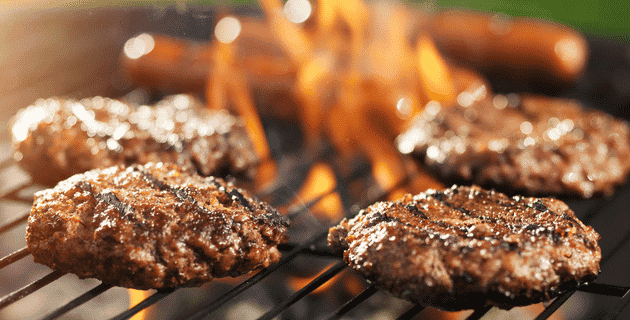
by California Casualty | Homeowners Insurance Info |
It’s time to break out the barbecue. July is National Grilling Month, a great time to host a backyard get-together!
Whether you prefer hot dogs or halibut, cheeseburgers, or charred veggies, everything tastes better on the grill. What’s even better than a mouthful of delicious BBQ? There’s no need to worry about a big mess, too, after you eat. Just clean the grill and you are good to go! Here are some of our favorite easy grill cleaning hacks to try all summer long.
1. Steam it! Use a handheld clothes steamer over your grill and watch it cut through grease. Then wipe it off. Don’t have a clothes steamer? Fill a metal container with boiling water. Place it inside your grill when it’s still hot. The resulting steam should loosen that stuck-on grease.
2. Use wet newspaper: When your grill is still warm, lay a sheet of wet newspaper over it. Then close the lid. Come back in a half hour and you’ll find a greasy, dirty piece of newspaper, which did much of the cleaning work for you. Simply finish it off with a good wipe. Repeat as needed.
3. Clean your grill with an onion: Cut a raw onion in half. Stick a BBQ fork into the rounded part and rub the cut side along the grill grates while they’re still hot. The onion’s juices will create steam and help to remove the bits of food residue.
4. Use leftover beer: If you have half a bottle or can of beer left, don’t throw it out. Pour it over a warm grill. Then scrub with a long-handled wire brush. A scrunched-up piece of aluminum foil works well, too, if you don’t have a brush. If you choose the foil, use tongs to move it around so you don’t burn your hands.
5. Spray it with vinegar: Fill a spray bottle with equal parts white vinegar and water. Spray the solution on a warm grill and leave it for 10 minutes. Then scrub it down. Vinegar is a natural cleaner that’s also food-safe.
6. Scour it with baking soda: Sprinkle some baking soda on the grill. Dissolve some more in water and make a soft paste. Then use a long-handled wire brush to apply the baking soda paste to the grill. Let it sit for 15 minutes. Then wipe it off with a dry cloth. Baking soda’s sandpaper action will have your grill sparkling before you know it.
7. Soak it in coffee: Coffee is naturally acidic and therefore great at loosening up caked-on dirt. So, brew a pot of cheap coffee and pour it into a large container. Then soak your grill grates and utensils for one hour. Rinse and dry the grates and utensils before replacing them.
8. Use an espresso machine cleaning solution: Espresso machines use special cleaning tablets and powders that work on grill parts. Add the tablet to hot water, immerse the grill parts, and let them soak. When the grime has loosened, scrub and rinse them clean.
9. Use your dishwasher: Some grill parts are small enough to fit into a dishwasher. This is an easy hack that will get those parts squeaky clean. For the best results, put them in when they are still warm (remember your pot holders).
10. Extreme temperatures: Fire up your gas grill and close the hood. Let it come to full temperature. Wait at least 30 minutes. Then turn off the heat and scrub it with a wire brush dipped in a bucket of soapy water. Disconnect and remove the tank and let the grill cool completely. Wipe as needed.
Other Grill Cleaning Tips
-
- Don’t throw water directly on your grill. On charcoal grills, it will make a mess. On any hot grill, it could cause scalding steam to fly back up at you.
- Do not lean over a warm grill while cleaning or you could be hit with that same burning steam.
- If you use a wire brush to scrub your grill, be sure to remove any loose wire brush bristles. Otherwise, they can get in your food.
- Before you use your grill, give it a good coating of sunflower or olive oil. It will help prevent food from sticking to it, and also protect against rust.
- Practice fire safety at all times. Grilling is the most fun when it’s done safely.
Bon appetit!
This article is furnished by California Casualty, providing auto and home insurance to educators, law enforcement officers, firefighters, and nurses. Get a quote at 1.866.704.8614 or www.calcas.com.
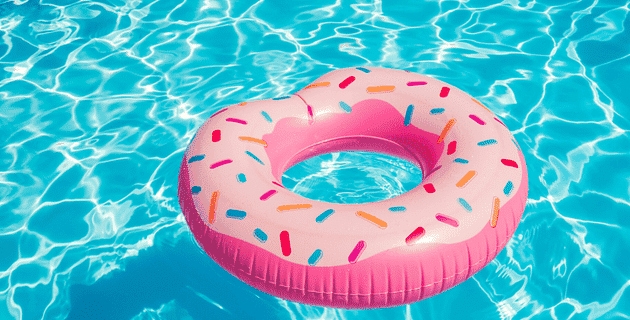
by California Casualty | Homeowners Insurance Info, Safety |
You’re a proud pool owner – or a soon-to-be one. You know how important it is to keep your pool clean, safe, and ready to swim.
We’ve compiled a list of 10 common maintenance mistakes that pool owners make, and how you can avoid them. Use this as your guide to ensure that your pool is ready to enjoy all season long.
1. Don’t ignore your pool’s pH level.
The pH is a measure of how acidic or basic your water is. If your pool’s pH is too low, the water is acidic—which is good to keep away algae but which can damage pool equipment like your pump and filter, heater, vinyl liner, and chemical feeder. When the pH is too high, however, it limits the effectiveness of your chlorine, the chemical that kills pathogens—microorganisms and bacteria that could be present in your pool. Pool pH that is too high also can cause skin rashes. That’s why a balanced pH is important.
Do: Test your pH levels at least twice a week. Keep the pH between 7.2 and 7.8.
2. Don’t add chlorine—or try to shock your pool—on a hot day.
It’s less effective to add chlorine to the water on a hot day. When chlorine is exposed to sunlight, it forms ions that convert to a gas that releases into the atmosphere. That requires you to add more chlorine for the right effect. Shocking—or adding a chemical mixture with a high dose of chlorine—has a similar effect. While you may want to do a shock treatment that helps to get rid of chloramines that can irritate eyes and skin, daytime is not the right time to do it.
Do: Add chlorine when temperatures are cooler, such as during the evening. Shock your pool once a week at night.
Pro Tip: Don’t think a strong chlorine smell means your pool has too much chlorine. When some contaminants in your pool oxidize, they can give off the scent of chlorine. If you smell chlorine, test your pool’s chlorine level. If needed, add chlorine until the water gives a reading between 3 and 5 parts per million (ppm).
3. Don’t do a shock treatment through your skimmer or put the shock chemicals directly into your pool without diluting them first.
Combining pool shock and chlorine can create a deadly gas, which can explode. That’s why you never want to add a shock treatment to a filter system with an automatic chlorinator. Putting those chemicals together in a confined space can cause an explosion in your pool’s filter system. Pool owners also have been burned and severely injured by mishandling of these chemicals. In addition, you don’t want to add shock directly into your pool. Shock is a form of concentrated chlorine; it can bleach anything within contact. Always dissolve the chemical into a bucket full of water. That will ensure it’s more evenly dispersed and it will protect your pool walls and floor.
Do: Follow manufacturer instructions when adding shock. Always wear proper safety gear.
Pro Tip: When diluting shock, put water in the bucket first and then add the chemicals. Putting chemicals in first can cause them to splash back on your arms or face.
4. Don’t run the pool filter system less than 8 hours each day.
Your pool’s filter and pump push water in and out of the system, cleaning it of dirt and keeping pool chemicals mixed. While running it less may seem like a cost-saving measure, it’s not. Inadequate pool filtering leads to more expensive treatments to remove algae and critters in your pool. While the size of your pool does matter, for most pools, 8 hours should do the trick.
Do: Keep your pool filter running at least 8 hours a day so it can do its job.
5. Don’t forget to brush.
Regular vacuuming helps to clear your pool of debris. Regular brushing helps to get those problem spots like the waterline, steps, and stairs, and behind ladders, corners and crevices. This helps to keep algae and other unwanted substances under control.
Do: Use an extra wide, heavy-duty aluminum pool brush with curved edges. Brush every week or more often if your pool is often used.
6. Don’t try to fix an algae problem with an automatic pool cleaner.
A robot simply pushes debris and algae around, and up through a mesh bag where it can clog. In other words, if you’re using an automatic pool cleaner, you’re just spreading the problem around. You’re not removing it.
Do: Use a manual vacuum. Make sure you either remove the drain plug or switch your filter to waste.
7. Don’t forget to check your calcium level.
Calcium helps to protect concrete, plaster, fiberglass, and vinyl. However, too much calcium makes the water cloudy. Again, you have to strive for that perfect balance. The recommended range is 175 to 225 parts per million (ppm).
Do: Check your calcium levels and as needed, add some calcium hardness increaser to the water. Note if you’re using calcium hypochlorite shock, you’re already adding calcium when you do the shock treatment.
8. Don’t backwash your pool filter too often.
Debris builds up in your pool’s filter over time. This sediment eventually begins to thicken and after a while prevents water from flowing through the filter. That’s the time to backwash. You’ll know because the pressure will be close to 10 psi. However, you don’t want to backwash too often. It could lead to cloudy or murky water because you’re also washing away the bed of fine sediment that helps your filter clear the water.
Do: Backwash only when your filter’s pressure gauge is 10 PSI. As the sand in your filter ages, and pressure increases regardless of backwashing, it may be time to change the filter media.
9. Don’t neglect your pool’s water level.
If your water level is too high, you’ll get water on the deck and most likely backwash that pushes dirt and debris back into the pool. If it’s too low, your pool’s pump might start filtering air instead of water, which could damage it.
Do: Keep your pool’s water level at the right height for the day’s swimmers and evaporative impact.
10. Don’t forget to prepare the pool for your furry friends—and clean up afterward.
Dog owners love sharing their pool with their furry friends. Yet the average-sized dog can introduce more contaminants to your pool than the average person. This includes pet hair that can clog filters to natural oils and even dirt. All of this can change your pool’s chemical levels. It’s good to know however that chlorine is considered safe for dogs as long as it is the recommended amount.
Do: Brush your dog before swimming to reduce the amount of pet hair. Rinse your dog after swimming to reduce chlorine exposure. Make sure your dog is safe in the summer heat. Vacuum your pool after each pet use. Regularly clean your filter, too.
Finally, don’t forget to protect your pool with the right homeowner’s policy, and take steps to minimize its risk as an attractive nuisance. That will provide peace of mind for you and your family to enjoy your pool and outdoor recreation all season long.
This article is furnished by California Casualty, providing auto and home insurance to educators, law enforcement officers, firefighters, and nurses. Get a quote at 1.866.704.8614 or www.calcas.com.

by California Casualty | Homeowners Insurance Info |
We love being outside in the summertime for a backyard barbecue or an evening gathering around the fire pit. Unfortunately, the bugs love it too. If you’re tired of itchy mosquitos, armies of ants, and other pesky pests, read on. We’ve got the answer for what bugs you!
Here are some of our favorite tips and tricks to keep backyard bugs away.
1. Start with scents.
Bugs hate strong smells of mint and citrus. They’re also not fond of some other scents. Here are some ways to use these smells against them.
-
-
- Put mint-flavored mouthwash in a spray bottle and spray your tables, chairs, and patio perimeter.
- Place a few drops of essential oils on cotton balls and place them around your entertaining area. Choose scents of peppermint, citrus, lavender, or eucalyptus.
- Make fly-repelling sachets of potpourri using cloves and bay leaves.
- Burn a citronella torch or candle. Citronella is made from bug repellant grasses and helps to mask the smell of carbon dioxide and human lactic acid, both of which attract some bugs.
2. Place your plants.
Some herbs and flowers are natural pest deterrents. Bringing them into your garden and around your entertaining areas can help keep bugs at bay. These plants are often bug-specific.
-
- To protect against mosquitoes, try basil, catnip, lavender, citronella, lemon-scented geraniums, lemon thyme, marigold, and rosemary plants.
- To ward off flies, try basil, catnip, and lavender plants.
- For moths and fleas, use lavender.
- Chrysanthemums help protect against roaches, ants, ticks, and fleas.
- Garlic and rosemary plants can repel biting insects.
- A chive and lemongrass garden can ward off other pests.
3. Mind your mulch.
Too much mulch gives cockroaches and ants the perfect home for nesting. You don’t want that too near your entertainment area or your home.
-
- Keep mulch at least 12 inches from the foundation.
- Consider replacing mulch with inorganic rock or gravel.
- Do make sure to have some mulch, grass, or ground covering. Yellow jackets make their nests by tunneling into bare dirt.
4. Turn on the fan.
Fans work in two ways to keep mosquitos away. Mosquitos aren’t strong fliers and so the breeze can prevent them from getting close. Fans also help disperse carbon dioxide and other chemical cues that mosquitos use to locate their hosts.
-
- Turn on the patio fan or bring a portable fan outside. Both will work. Set them on medium or high settings.
- Oscillating fans may be even more effective, as they help to move the air in different directions.
- Consider several fans blowing in different directions to cover your entertaining area.
5. Redo your outdoor lighting.
Bright white or bluish lights attract insects because they emit shorter wavelengths. Bulbs that burn hotter also attract their share of bugs. Switch your outdoor lighting to reduce the number of your nightly “visitors.”
-
- Replace white light bulbs with longer wavelength colors like yellow ones. The orange or yellowish glow is less visible to some insects.
- Replace your incandescent and halogen bulbs, which give off a lot of heat, for ones that don’t. LED and fluorescent bulbs emit much less heat than others with the same wattage.
- Reduce the wattage. Rather than 100 watts, try 60. Dimmer bulbs are harder for insects to see.
Pro Tip: If you are using older LED bulbs, you will need to replace them. Early versions had a coating that gave off more heat than current models.
6. Address standing water.
Standing water is the perfect nursery for mosquitos, gnats, and other bugs. Make sure you don’t have any standing water on your property, or if you do, take steps to eliminate or reduce the risk.
-
- Remove standing water from gutters and downspouts.
- Keep kiddie pools, buckets, and watering cans empty when they are not in use.
- Get a birdbath with running water to reduce the chance of mosquitoes breeding.
- Treat standing water with mosquito dunk pellets. This will allow them to fly but they will be sterile and cannot reproduce.
7. Build a bat house.
Attracting the predators that eat bugs can help you naturally reduce the insect population. One small bat can eat up to 1,000 mosquitoes an hour, which is a great reason to buy or build a bat house.
-
- Buy or build one that is at least 24 inches high by 16 inches wide.
- Bats prefer to roost on buildings or concrete structures rather than trees. It helps protect them against their predators.
- Mount the house at least 10 feet off the ground and 20-30 feet from the nearest tree if possible.
- The location should have a nearby water source and at least 6 hours of daily sun.
8. Build a bug trap.
Commercial bug traps are available, but it’s easy to make your own from materials that you probably already have around the house. Put your bug trap outside a few hours before you entertain or anytime you want a bug-free area.
-
- Start with a 2-liter soda bottle. Take off its cap and throw that away.
- Measure about 4 inches from the top of the spout and mark that. Use that line to cut around the bottle so that it is now in 2 pieces.
- Insert the spout inside the open top so it points back down to the bottom.
- Tape the pieces together to seal them.
- Fill with soda or a sweet liquid to attract bugs, bees, wasps, etc.
Pro Tip: Fill a small bowl of apple cider vinegar and mix in a few drops of dish detergent. The scent will attract fruit flies and the soap will create a barrier that prevents their escape.
9. Keep it clean.
Keeping your patio or deck clean will help deter bugs. That’s because any morsel of food or sticky substance can attract them.
-
- Sweep any crumbs. Wipe away spilled liquid.
- Make sure all your garbage cans and recycling bins have covers to prevent breeding flies. Move them away from your entertaining spots.
- Fill a spray bottle with a mixture of one part hydrogen peroxide to two parts water. Spray your patio or deck surface and perimeter. Be careful not to mix this with food or drinks.
- Ticks like to hide in tall grass so keep your grass mowed and maintain your lawn. Trim back bushes or tree branches that touch your home, and which help pests get inside.
This article is furnished by California Casualty, providing auto and home insurance to educators, law enforcement officers, firefighters, and nurses. Get a quote at 1.866.704.8614 or www.calcas.com.
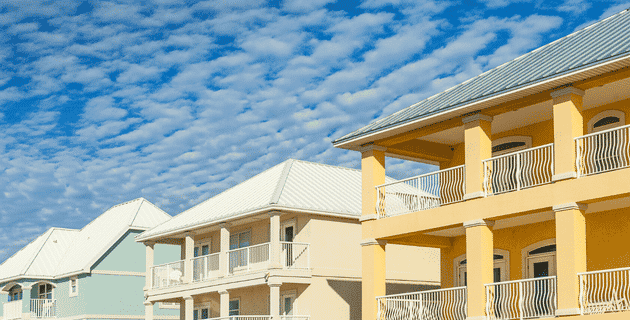
by California Casualty | Homeowners Insurance Info |
You’re going on vacation and renting a beautiful property for the week. You’re not expecting anything to go wrong, but what happens if something does? What if you break something, or if you get injured? What if your stuff gets damaged or stolen?
Read on to find out the answers to common questions about insurance coverage for vacation rentals. Knowing what to expect before your vacation will help you make sure you’re covered.
What if something happens to my stuff?
You went out to dinner and came home to find your stuff stolen—a vacation surprise no one would want. Fortunately, your homeowner’s policy or a renter’s policy (at your permanent residence) can help. Your policy will cover your property for 16 named perils or occurrences (i.e. fire, theft, explosion) subject to special limits. However, if your property is damaged because you dropped it or your child spilled juice on it, there is no coverage.
Personal property coverage is that part of your policy that protects your possessions. If they are stolen, or damaged by fire/smoke or other covered “perils” anywhere in the world, your policy will pay for them. That’s true whether your belongings are at your primary home, in your car, or with you on vacation. There are dollar limits for certain items such as money, jewelry, and firearms, so check with your insurer. For personal property coverage on a homeowner’s policy, you typically get 50 or 75% of Coverage A, the total amount of coverage for your home. Renters get to choose the amount of personal property coverage.
How will you be compensated? It depends what you selected for your policy: replacement cost or actual cash value (ACV). ACV is the amount the item is worth, minus depreciation for its age. It will cost a little more for a policy that provides replacement cost since that is higher than ACV. You will get reimbursed minus the amount you have chosen for your deductible, the amount you pay out-of-pocket before your insurance company pays a claim. That’s why all of these decisions when you set up a policy are so important.
What happens if you get hurt at your vacation rental?
Maybe you were minding your own business, and preparing snacks for your day at the beach when a loose tile in the kitchen caused you to trip and fall. As a result, your vacation included a visit to Urgent Care. In this case, the owner of the rental property might reimburse you for your medical bills under Coverage F – Medical Payments To Others of their Property Policy. At California Casualty, we pay the necessary medical expenses that are incurred or medically ascertained within three years from the date of an accident. This coverage however does not involve negligence or liability. After all, the rental property owner didn’t know about the loose tile.
Pro Tip: Because the rental property owner’s policy is the one that would cover medical expenses, make sure that they have coverage.
What happens if you damage the property during your stay?
Let’s say you accidentally put a hot pan on the kitchen counter and the resulting mark doesn’t come off (oops!). You’ll need to pay for the repair. It’s the same if you place the plan there and intentionally caused the damage. The only time your homeowner’s policy will pay for a place that you rent, and do not own, is for property damage caused by fire, smoke, or explosion. Of course, it cannot be intentional.
Are you insured for vacation homes outside the country?
Your homeowner’s or renter’s personal property coverage protects your belongings when they are with you wherever they are. Similarly, your homeowner’s or renter’s liability coverage protects you from damage that you may cause to others or their property anywhere in the world.
When should you file a homeowner’s insurance claim?
If the damage is greater than your deductible, you may wish to file a claim. If it’s not, or if the difference is not much, you may to decide to pay out-of-pocket rather than going through insurance. For example, if the damage if $1,500 and your deductible is $500, you could file a claim. However, if the damage is $750 and your deductible is $500, you may decide to pay the difference. Know that filing a claim can cause your premiums to rise over time.
In addition, some vacation rentals charge a security deposit to cover any damage. Check with your prospective rental so you’ll know going in what to expect.
Finally, talk to your insurance agent and do a policy review to make sure you are fully covered for your vacation rental and other summer fun.
This article is furnished by California Casualty, providing auto and home insurance to educators, law enforcement officers, firefighters, and nurses. Get a quote at 1.866.704.8614 or www.calcas.com.
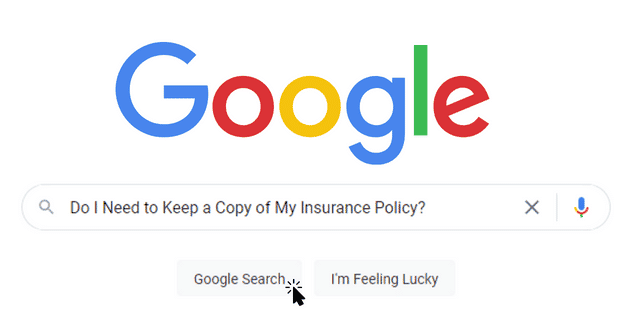
by California Casualty | Auto Insurance Info, Homeowners Insurance Info |
If you’ve ever sat down to read a declaration page on an insurance policy, you know there’s a lot that goes into the documentation. This information is clearly important, but there’s a lot of paperwork. Do you really need to keep it all, and for how long?
Here’s a quick reference guide for your insurance paperwork, including how to organize it, store it, and for how long.
Insurance Policy
Whether you have home insurance, an auto policy, a renter’s policy, or another type of coverage, you will be issued a document that spells out the insurance coverage. This main policy document is multiple pages. It includes all the details of your policy, including coverages and limits, discounts, and endorsements. It also is a resource with definitions of insurance terms and explanations of the claims process. If you are bundling your coverages, such as with home and auto, you will have an insurance policy document for each.
You need to know the coverage that you have, but you don’t necessarily need a hard copy of your policy document. If your insurer offers digital access on their website, you can toss the paper version. Either way, you will want to keep a hard copy of the declarations page.
Certificate of Insurance (COI)
This document is the summary of your coverage. Its format is easy to scan and provides a quick look at your coverage details. It’s especially useful to share with lenders who require proof of insurance if you are financing your home or car.
Keep a copy of your certificate of insurance for as long as the policy is active. It is your proof of insurance. When you renew your policy, you can throw out the old COI.
Insurance Claims Documents
Accidents happen, and things get damaged and stolen. You may file a claim with your insurance company when this happens. If your claim is for an auto policy, you will get an accident report. You also may have medical reports and bills. If your claim is for home damage or theft, you will have an inventory of damage. You also will have repair bills, receipts, and other paperwork. If it’s a third-party claim, where you caused injury or loss to another person, you will receive documentation as well.
Claims can sometimes take years, especially if medical bills are involved. As long as your claim is open, keep all of the paperwork. Only throw it out after you have received the payment.
Vehicle Insurance Card
Your auto insurance card fits in your wallet or glove compartment, which is where it should be kept. That way, you have a hard copy even if you have access to a digital version. Hard copies are useful in case you are pulled over by law enforcement or need to exchange the information with another driver in the event of an accident.
Keep the hard copy of your auto insurance card as long as your policy is active. You may dispose of it when the policy renews and you receive a new card.
Billing Statements
You will receive regular billing statements from your insurer, usually monthly. These may be by mail or online.
Keep your billing statements for tax purposes if you have a home business or you use your car for business purposes. If you’re audited by the IRS, you may need to show your bills for the last 7 years.
How to Store Documents
If you’re keeping paper copies of documents, you want to make sure that they remain in good, readable condition. Here are some recommendations to keep them that way:
-
- Never store your important papers in a basement in case of flooding.
- Keep your documents in a safe container in a climate-controlled space to reduce the possibility of mold and fading.
- Store papers in a waterproof and fire-resistant container. Consider a home lock box or safe or a filing cabinet.
- Consider digital storage as well, as a backup. You can store copies of papers on a flash drive. For a small fee, you also can store them in Dropbox and on iCloud and other services.
Pro Tip: Use plastic page sleeves for your documents for added protection. You can slide your documents into the sleeves and then file them in a binder or box.
How to Dispose of Documents
The general rule is that once a policy is done, you don’t need to keep the paperwork. (See the exceptions for claims documents and billing statements above.) But your insurance documents have personal information that could lead to identity theft if not disposed of safely.
-
- Always shred any old papers. Use a crosscut shredder that cuts in two directions to produce confetti.
- A small home shredder will work or you may find a free shredding event in your community.
- Local banks and other companies also may shred your papers for a fee.
- Remember to permanently delete old digital copies as well.
Going Paperless
Did you know, you can access your account online with California Casualty? Once you’ve signed up, you will have quick access to your policy(ies) at any time and from anywhere. You simply “Sign In” in the same right-hand corner where you created your account initially. And easy, secure access to this policy portal gives you the flexibility to:
-
- Download/Print ID Cards
- View/Download Your Declaration Pages
- Pay Your Bill Online
- Make Some Changes to Your Policy (Manage Drivers, Manage Vehicles, Manage Lienholders/Mortgagee)
- Contact Customer Service for Additional Support
- File a Claim
- Create/Save a New Auto Quote, etc.
Click here to learn more.
This article is furnished by California Casualty, providing auto and home insurance to educators, law enforcement officers, firefighters, and nurses. Get a quote at 1.866.704.8614 or www.calcas.com.






